American Abstract Artists Exhibit
Visible Histories Exhibit at the Morris-Warren Gallery LES
February 1, 2016 / Lower East Side Neighborhood / Manhattan Art Galleries & Artists / Manhattan Buzz NYC.
 I attended the opening reception for a new exhibit at the Morris Warren Gallery at 171 Chrystie Street, just east of SoHo on the Lower East Side. The exhibit is entitled Visible Histories and it features 60 artists who are members of the American Abstract Artists group.
I attended the opening reception for a new exhibit at the Morris Warren Gallery at 171 Chrystie Street, just east of SoHo on the Lower East Side. The exhibit is entitled Visible Histories and it features 60 artists who are members of the American Abstract Artists group.
In the early part of the 20th century, American abstract artists found it difficult to gain recognition and respect – and hence venues – where they could exhibit their work. It’s important to remind readers that widespread use of television and the internet were many decades away, and that even print publishing was just beginning to emerge as a mass media. Thus art shows and the attendant publicity they generated, were critical to the emergence of new art forms and new artists.
The first notable American abstract art show opened in 1913 at the 69th Infantry Armory at Lexington Avenue & 26th Street. Two decades later in 1936, the American Abstract Artists group was founded by New York City artists seeking to find exhibit venues and recognition for their nascent abstract art form. The American Abstract Artists group went on to survive the remainder of the Great Depression, WWII and today is one of the oldest, continuously operating artist groups in the nation.
Follow us to the next page as we continue our journey into the New York City art world. Our report includes a bit of history about the evolution of American art and modern art in Manhattan as well as a closer look at the Visible Histories exhibit including excerpts from discussions with the curator, gallery owners and one of the artists.
Click here for the American Abstract Artists at the Morris-Warren Gallery on the Lower East Side LES.
American Abstract Artists Exhibit
Visible Histories Exhibit at the Morris-Warren Gallery LES
February 1, 2016 / Lower East Side Bowery Neighborhood / Manhattan Art Galleries & Artists / Manhattan Buzz NYC. Continued.
Art in America & Europe: Mid to Late 19th Century
 American abstract art emerged early in the 20th century. During this period, Post Impressionist artists like Degas and Van Gogh had continued loosening art depictions from accurate, realistic replications of their subjects to interpretative works. This evolutionary transition may have been ignited by photography, which was invented in 1839, enabling anyone with a camera to accurately capture an accurate representation of their subjects. The Impressionists and Post Impressionists were at the beginning of the abstraction process, which would continue throughout the 20th century.
American abstract art emerged early in the 20th century. During this period, Post Impressionist artists like Degas and Van Gogh had continued loosening art depictions from accurate, realistic replications of their subjects to interpretative works. This evolutionary transition may have been ignited by photography, which was invented in 1839, enabling anyone with a camera to accurately capture an accurate representation of their subjects. The Impressionists and Post Impressionists were at the beginning of the abstraction process, which would continue throughout the 20th century.
At the dawn of the 20th century, Europe was the art center of the western art world. The art abstractions that began around the dawn of the 20th century picked up momentum as the century wore on. The European art market had a sophistication and long history of being supported by the wealthy, educated upper classes. America was an emerging economic force to be reckoned with, but had yet to take its seat at the arts and culture table. American artists during the 19th century were doing real life depictions of America’s raw, natural beauty through landscapes [like those done by the Hudson School], as well as through the creation of a variety of portraits.
Culture & the Arts Emerge in Manhattan: 1870 - 1902
 The Metropolitan Museum was first conceived in Paris, France by several Americans. A lawyer, John Jay, was among them, and it was he who took the idea and began running with it upon his return to the United States. In 1870 the Metropolitan Museum was opened and its mission was to provide a national institution and gallery of art which would bring art and art education to the American public.
The Metropolitan Museum was first conceived in Paris, France by several Americans. A lawyer, John Jay, was among them, and it was he who took the idea and began running with it upon his return to the United States. In 1870 the Metropolitan Museum was opened and its mission was to provide a national institution and gallery of art which would bring art and art education to the American public.
By 1902, with the help of wealthy American donors, the Metropolitan Museum moved into its current location along 5th Avenue at 82nd Street. In just thirty years the Metropolitan Museum of Art had become an internationally recognized art museum and in tandem New York City was also rapidly gaining credibility as an important arts and cultural center.
National Academy of Design: Manhattan
At the turn of the 20th century, the National Academy of Design was the ruling arbiter of good taste when it came to art. The National Academy of Design was reportedly rooted in the the old traditions of the past - the status quo - as is almost inevitable, eventually, for any long-ruling arbiter. Thus American modern artists were struggling for recognition and respect.
International Exhibition of Modern Art: The Armory Show: 1913
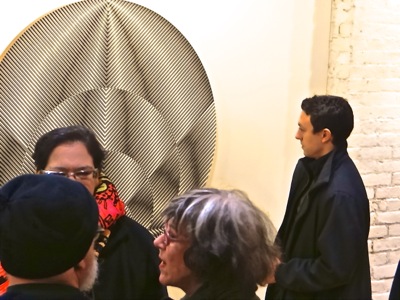 Then in 1913 the International Exhibition of Modern Art [better known as the Armory Show] began to open America’s mind to a bigger world … the world of abstract art, which is known today as modern art. The 1913 International Exhibit of Modern Art was organized by Walter Kuhn and included the works of Pablo Picasso, Henri Matisse, Marcel Duchamp, Paul Gauguin, Paul Cézanne, and Vincent Van Gogh on display in the same place at the same time. It stunned the viewing public, many of whom found it reprehensible, but it could not be ignored and it has yet to be forgotten. It changed the art world in America, as the show traveled to Chicago and Boston as well.
Then in 1913 the International Exhibition of Modern Art [better known as the Armory Show] began to open America’s mind to a bigger world … the world of abstract art, which is known today as modern art. The 1913 International Exhibit of Modern Art was organized by Walter Kuhn and included the works of Pablo Picasso, Henri Matisse, Marcel Duchamp, Paul Gauguin, Paul Cézanne, and Vincent Van Gogh on display in the same place at the same time. It stunned the viewing public, many of whom found it reprehensible, but it could not be ignored and it has yet to be forgotten. It changed the art world in America, as the show traveled to Chicago and Boston as well.
The Amory Show, as it came to be called, was also mocked and derided by other ruling elites including the New York Times and former President Theodore Roosevelt. Yes, it made waves and changed things forever.
Alfred H. Barr & the Museum of Modern Art: 1929 - 1940
Fast forward to 1929 when the Museum of Modern Art was conceived and founded by Miss Lillie P. Bliss, Mrs. Cornelius J. Sullivan, and Mrs. John D. Rockefeller, Jr. Reportedly, these women along with others, conceived the idea, enlisted critical support and helped gather the resources required to fund the new art museum which was intended to challenge the artistic status quo. Wealthy Americans helped fund the museum through contributions and gifts.
 Alfred H. Barr Jr. was chosen to be the founding director of the Museum of Modern Art. In 1935 Barr brought the Van Gogh collection to the museum, which received rave reviews. He also engineered the Picasso exhibition of 1939 - 1940, and had the Museum of Modern Art host exhibits of many of the leading Post Impressionist artists including Cézanne, Gauguin, and Seurat.
Alfred H. Barr Jr. was chosen to be the founding director of the Museum of Modern Art. In 1935 Barr brought the Van Gogh collection to the museum, which received rave reviews. He also engineered the Picasso exhibition of 1939 - 1940, and had the Museum of Modern Art host exhibits of many of the leading Post Impressionist artists including Cézanne, Gauguin, and Seurat.
The Museum of Modern Art Manhattan Today
According the moma.org website the Museum of Modern Art, or MoMA as it is known today, is home to:
“over 150,000 paintings, sculptures, drawings, prints, photographs, architectural models and drawings, and design objects. MoMA also owns approximately 22,000 films and four million film stills, and MoMA's Library and Archives, the premier research facilities of their kind in the world, hold over 300,000 books, artist books, and periodicals, and extensive individual files on more than 70,000 artists.”
Thus in the course of a few decades, New York City – in the borough of Manhattan – erected institutions like the Metropolitan Museum of Art, the Frick Museum and the Museum of Modern Art. During WWII several prominent artists moved to America, specifically Manhattan, to flee the war.
The Modern Art World Moves & Emerges in NYC: 1930's & 1940's
 Following World War II, with Europe in shambles, America emerged as an international art destination and as one of the leaders – if not the leader – in avant-garde art. American artists like Man Ray, Pollock, Rothko and De Kooning took abstract art from Cubism, Dada and Surrealism into abstract expressionist art. And of course, today New York City continues to be one of the leading modern art centers for the nation and the world.
Following World War II, with Europe in shambles, America emerged as an international art destination and as one of the leaders – if not the leader – in avant-garde art. American artists like Man Ray, Pollock, Rothko and De Kooning took abstract art from Cubism, Dada and Surrealism into abstract expressionist art. And of course, today New York City continues to be one of the leading modern art centers for the nation and the world.
American Abstract Artists at the Morris-Warren Gallery LES
With the above short history as background, we fast forward to New York City on January 30, 2016 on Chrystie Street where there’s an exhibit entitled Visible Histories. The exhibit includes 60 artists who are members of American Abstract Artists, a group that originated, as I stated in the introduction, in 1936.
American Abstract Artists 80th Anniversary: 1936 - 2016
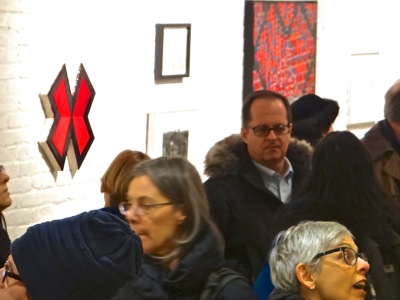 The Museum of Modern Art had emerged as a well funded, successful venue for modern art. But there were those who thought that the museum showed a strong preference for European abstract artists in lieu of America’s own. Hence, American Abstract Artists was formed by in 1936 by Carl Holty, Harry Holtzman, George L. K. Morris and others. They sought to embrace all forms of abstract art, not just certain popular strains of it.
The Museum of Modern Art had emerged as a well funded, successful venue for modern art. But there were those who thought that the museum showed a strong preference for European abstract artists in lieu of America’s own. Hence, American Abstract Artists was formed by in 1936 by Carl Holty, Harry Holtzman, George L. K. Morris and others. They sought to embrace all forms of abstract art, not just certain popular strains of it.
Europeans who fled the continent following the outbreak of WWII, including Dutch painter Piet Mondrian [abstract geometric / minimalist], French Fernand Leger [cubism], and painter and photographer Laszlo Moholy-Nagy [constructivism / use of technology in art] were among the best known immigrating artists who sought and found fellowship through American Abstract Artists group. Mondrian was featured just before his death in 1944 at the Museum of Modern Art [1942 – 1943].
Visible Histories Art Exhibit Curator Max Weintraub
 I had an opportunity to speak with Max Weintraub, curator for the exhibit Visible Histories, about it. He told me that this was the 80th anniversary of the American Abstract Artists group and that he was seeking a theme which embraced the group’s history [Max is an Art Historian at Hunter College].
I had an opportunity to speak with Max Weintraub, curator for the exhibit Visible Histories, about it. He told me that this was the 80th anniversary of the American Abstract Artists group and that he was seeking a theme which embraced the group’s history [Max is an Art Historian at Hunter College].
Max went on to explain his intent with the exhibit. He said that abstraction is,
“Abstract art is often thought of as being grounded in the present tense, with little clear or direct connection to the art that came before it. But of course it always responds to the past one way or another. The intent of this exhibition is not to define abstract art only through its connection to the past, but to celebrate the dialogue the works do have, implicitly or explicitly, with the long and rich history of abstraction.”
You have to think about what he said to really understand it, because it’s so abstract.
Visible Histories Showcases Sixty NYC Artists
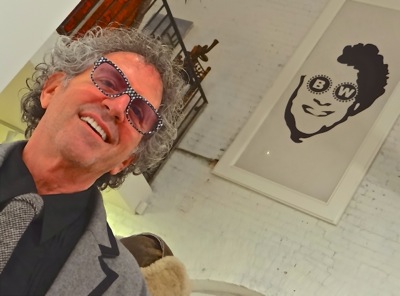 Max told me that the show includes 60 artists, each of whom submitted several works from which he chose one to show. He told me that he’s only been affiliated with the American Abstract Artists group for about a year or so, and that he’s enjoyed working with them and that they have an interesting history, some of which has been recited above.
Max told me that the show includes 60 artists, each of whom submitted several works from which he chose one to show. He told me that he’s only been affiliated with the American Abstract Artists group for about a year or so, and that he’s enjoyed working with them and that they have an interesting history, some of which has been recited above.
The show is currently on exhibit at two venues, this one – the Morris-Warren Gallery at 171 Chrystie Street and the Abron Arts Center at 466 Grand adjacent to the Henry Street Settlement House. Both venues are located in the Bowery on the Lower East Side.
Max told me that he began curating shows about five years ago and that the venues came about through a conversation with one of the artists, Edward Shalala, who lives in the Lower East Side neighborhood.
Morris-Warren Gallery Owners: Brian Morris & Buddy Schussel
 The Morris-Warren Gallery is owned by two partners, Buddy Schussel and Brian Morris. I met Buddy Schussel while viewing some of the works near the back of the gallery. Buddy is not just the gallery owner, but is also an interior designer.
The Morris-Warren Gallery is owned by two partners, Buddy Schussel and Brian Morris. I met Buddy Schussel while viewing some of the works near the back of the gallery. Buddy is not just the gallery owner, but is also an interior designer.
Buddy Schussel moved into 171 Chrystie Street in the Lower East Side neighborhood with his design gallery back in 2013. He told me that the location was a sort of black hole of Calcutta and that it took him about six months to get it working.
Morris-Warren Art Gallery Lower East Side LES: Buddy Schussel
Buddy pointed to the large black door in the back of the gallery. He told me that it was once a stable door and that the Morris-Warren gallery was once a carriage house dating back to the 1800’s. He directed my attention to the skylights on the airy ceiling and informed me that he’d installed these upon learning that the openings existed. He wasn’t exactly sure what the building had been before, but noted that it had an unusual vibe, giving consideration to the possibility that it may have been a speakeasy or brothel or possibly both at various times, but none of this could be confirmed by either of us.
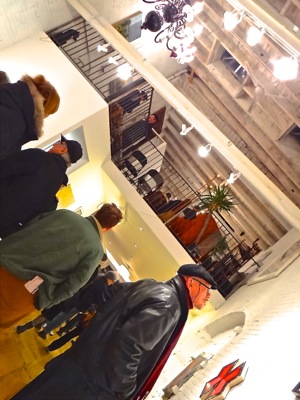 Buddy told me that tonight was the first opening of the upstairs gallery which was housing a separate exhibit entitled, New York Waterways, which included paintings by an artist of the urban scenes he’d spotted from his boat. Buddy informed me that they do shows about every month or so, having done eight shows since the partnered gallery first opened in late 2014 / early 2015. The next show features Kim Uchiyama and begins after this one closes on February 21st, 2016.
Buddy told me that tonight was the first opening of the upstairs gallery which was housing a separate exhibit entitled, New York Waterways, which included paintings by an artist of the urban scenes he’d spotted from his boat. Buddy informed me that they do shows about every month or so, having done eight shows since the partnered gallery first opened in late 2014 / early 2015. The next show features Kim Uchiyama and begins after this one closes on February 21st, 2016.
Morris-Warren Gallery Owner: Brian Morris
It wasn’t long after my conversation with Budde Schussel that I talked to the other partner of the Morris-Warren Gallery, Brian Morris. Brian is an artist, to be sure, but he told me, he’s a martial artist.
Brian Morris opened an art gallery on Chrystie Street, not too long before Budde Schussel opened his design store. This was in 2013, following the heels of the demise of an online art magazine Brian and several others founded, entitled Glass Chord. The online magazine archives are still up where you can see that it was the beginning of the arts community, several of whom I met this evening at the Morris-Warren Gallery.
Brian told me that after opening the Brian Morris Gallery they did shows featuring in the neighborhood of 150 plus artists and that he did in the neighborhood of two shows per month at different locations. Brian and Buddy got to know each other as retail neighbors and decided to join forces creating the Morris-Warren Gallery.
American Abstract Artist: Jeanne Wilkinson
 Last, but not least, I was able to spend time with one of the featured artists, Jeanne Wilkinson. I met Jeanne at a prior art opening many years ago in Queens. Since then I’ve electronically watched her work and exhibitions evolve, waiting for her to participate in another exhibit in one of my coverage areas.
Last, but not least, I was able to spend time with one of the featured artists, Jeanne Wilkinson. I met Jeanne at a prior art opening many years ago in Queens. Since then I’ve electronically watched her work and exhibitions evolve, waiting for her to participate in another exhibit in one of my coverage areas.
Jeanne is a member of American Abstract Artists, and one who loves working with the complexity of layers. While talking about the work she had on exhibit in Visible Histories, she explained to me that she loves using technology to create art and that like great scientific discoveries, sometimes the most interesting work emerges from an ‘accident’. This resonated with me for its inherenet truth, as well as its layered juxtaposition vis a vis what Max had said about abstract art being in the moment.
The piece Jeanne had on display was one such accident. She was working on a photo doing what she loves to do, layering it with special effects, when the underlying file disappeared. Only the colors and special effects remained. I suppose you could call this a pure technical abstraction.
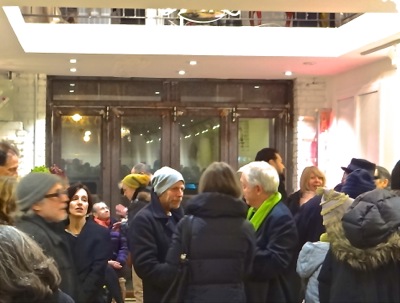 I asked her what the underlying image was, which she replied,
I asked her what the underlying image was, which she replied,
“a kind of flower-like shape created by an animation effect called 'flo-motion' "
I asked her if she’d given a name to the piece. She told me it was,
"Empty Abstraction #1"
Jeanne compared the layers she adds to her artwork, as similar to the layers of a lotus flower. One continuously peels away the layers of the lotus flower, while conversely one continuously adds layers in life: the layers of childhood, teen years, marriage, children, as well as professional and community roles and, of course, all of the roles played in our personal lives. Layers and layers of complexity, which like the lotus flower, are part of the larger whole.
Abstract Art in Manhattan - Lower East Side Art Galleries
Hmm. Abstractions, allegories, metaphors and art.
Is beauty really in the eye of the beholder?
And is life really what you make of it?
At this point I was beginning to find my visit more than a journey into the world of abstraction, it was beginning to feel downright existential.
The Visible Histories art exhibit opening at the Morris-Warren Gallery had the feeling of a great party, even though there weren't any drugs, sex or rock n’ roll while I was there. But what was there, was an invisible vibe of artistic ambiance that surrounded me with a fun, frolicking, contemplative feeling which stayed with me as I made my way home.
Epilogue - End of an Artful Evening
 At times I have thought that this sort of inspired intellectualism, pursuit of art for its own sake, had been completely vanquished by the moneyed developers and landed gentry of Manhattan. That the real artists and intellectuals of Manhattan had been completely dispersed and cast out of Manhattan. But thankfully this is not the case.
At times I have thought that this sort of inspired intellectualism, pursuit of art for its own sake, had been completely vanquished by the moneyed developers and landed gentry of Manhattan. That the real artists and intellectuals of Manhattan had been completely dispersed and cast out of Manhattan. But thankfully this is not the case.
But the money always follows the art world, and capitalizes on their success, sending artists fleeing in pursuit of lower rents. So you have to enjoy these places, these people and these times in the moment because – like abstract art – they are Visible Histories - here today, and gone tomorrow.
You can view Visible Histories, purchase artwork and / or get connected via the Morris-Warren Gallery at 171 Chrystie or via the www.AmericanAbstractArtists.org website.
The Visible Histories exhibit runs through February 21st at the Morris-Warren Gallery at 171 Chrystie Street and at the Abrons Art Center, 466 Grand St. - both on the Lower East Side.
Sources: Sources: The Art Story.org, Wikipedia.org, AmericanAbstractArtists.org, ArtandEducation.net, NYHistory.org, moma.org, metmuseum.org.
Lower East Side Neighborhood NYC - Manhattan Related Info
Click this link for promotions, discounts and coupons in Manhattan.
Manhattan NYC Related Links
Click for Manhattan Restaurants
Click for Manhattan Neighborhoods
Click for Manhattan Things To Do
Click for Gramercy Park Restaurants
Click for Manhattan Hotels
Click for New Years Parties & Restaurants
Click for Manhattan Furniture Stores
Click for Manhattan Street Fairs
Click for Manhattan Professional Services
Click for Manhattan Farmers Markets
Click for Manhattan Real Estate
Archives - TBD
Site Search Tips. 1) For best results, when typing in more than one word, use quotation marks - eg "Astoria Park". 2) Also try either singular or plural words when searching for a specific item such as "gym" or "gyms".
$element(bwcore,insert_search,N)$
Click this link to search for something in our Manhattan Business Directory.
Click the log in link below to create an ID and post an opinion.
Or send this story to a friend by filling in the appropriate box below.




















